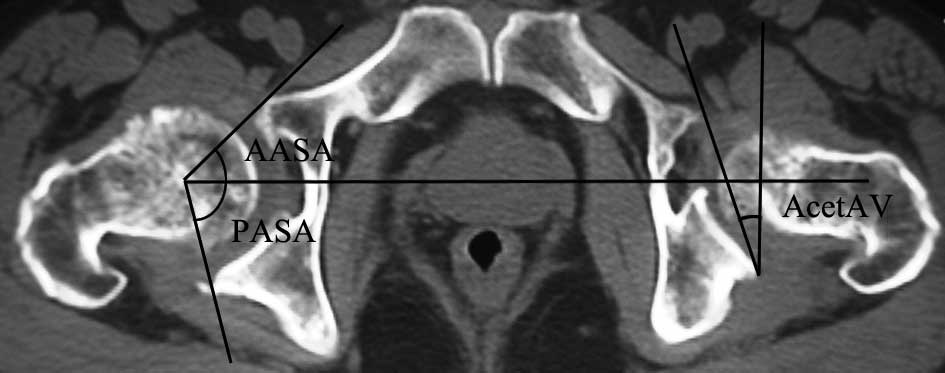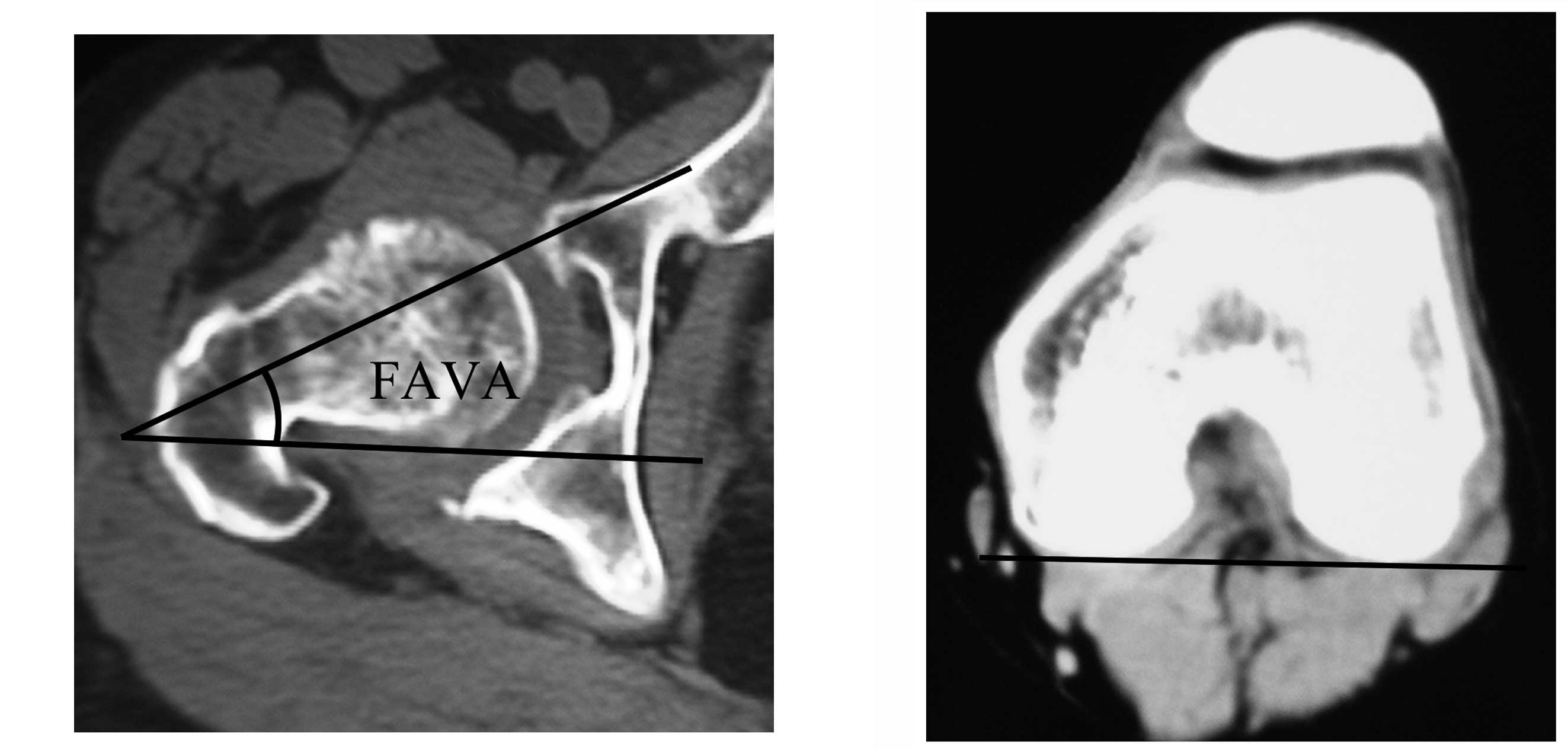|
1.
|
Hartofilakidis G, Yiannakopoulos CK and
Babis GC: The morphologic variations of low and high hip
dislocation. Clin Orthop Relat Res. 466:820–824. 2008. View Article : Google Scholar : PubMed/NCBI
|
|
2.
|
Xu WD, Li J, Zhou ZH, Wu YS and Li M:
Results of hip resurfacing for developmental dysplasia of the hip
of Crowe type I and II. Chin Med J (Engl). 121:1379–1383.
2008.PubMed/NCBI
|
|
3.
|
Jasty M, Anderson MJ and Harris WH: Total
hip replacement for developmental dysplasia of the hip. Clin Orthop
Relat Res. 311:40–45. 1995.PubMed/NCBI
|
|
4.
|
Sugano N, Noble PC, Kamaric E, Salama JK,
Ochi T and Tullos HS: The morphology of the femur in developmental
dysplasia of the hip. J Bone Joint Surg Br. 80:711–719. 1998.
View Article : Google Scholar : PubMed/NCBI
|
|
5.
|
Akiyama M, Nakashima Y, Fujii M, et al:
Femoral anteversion is correlated with acetabular version and
coverage in Asian women with anterior and global deficient
subgroups of hip dysplasia: a CT study. Skeletal Radiol.
41:1411–1418. 2012. View Article : Google Scholar : PubMed/NCBI
|
|
6.
|
Spangehl MJ, Berry DJ, Trousdale RT and
Cabanela ME: Uncemented acetabular components with bulk femoral
head autograft for acetabular reconstruction in developmental
dysplasia of the hip: results at five to twelve years. J Bone Joint
Surg Am. 83-A:1484–1489. 2001.PubMed/NCBI
|
|
7.
|
Jawad MU and Scully SP: In brief: Crowe’s
classification: arthroplasty in developmental dysplasia of the hip.
Clin Orthop Relat Res. 469:306–308. 2011.PubMed/NCBI
|
|
8.
|
Yiannakopoulos CK, Chougle A, Eskelinen A,
Hodgkinson JP and Hartofilakidis G: Inter- and intra-observer
variability of the Crowe and Hartofilakidis classification systems
for congenital hip disease in adults. J Bone Joint Surg Br.
90:579–583. 2008. View Article : Google Scholar : PubMed/NCBI
|
|
9.
|
Argenson JN, Flecher X, Parratte S and
Aubaniac JM: Anatomy of the dysplastic hip and consequences for
total hip arthroplasty. Clin Orthop Relat Res. 465:40–45.
2007.PubMed/NCBI
|
|
10.
|
Shen B, Yang J, Wang L, Zhou ZK, Kang PD
and Pei FX: Midterm results of hybrid total hip arthroplasty for
treatment of osteoarthritis secondary to developmental dysplasia of
the hip-Chinese experience. J Arthroplasty. 24:1157–1163. 2009.
View Article : Google Scholar : PubMed/NCBI
|
|
11.
|
Noble PC, Kamaric E, Sugano N, Matsubara
M, Harada Y, Ohzono K and Paravic V: Three-dimensional shape of the
dysplastic femur: implications for THR. Clin Orthop Relat Res.
417:27–40. 2003.PubMed/NCBI
|
|
12.
|
Ito H, Matsuno T, Hirayama T, Tanino H,
Yamanaka Y and Minami A: Three-dimensional computed tomography
analysis of non-osteoarthritic adult acetabular dysplasia. Skeletal
Radiol. 38:131–139. 2009. View Article : Google Scholar : PubMed/NCBI
|
|
13.
|
Paliobeis CP and Villar RN: The prevalence
of dysplasia in femoroacetabular impingement. Hip Int. 21:141–145.
2011. View Article : Google Scholar : PubMed/NCBI
|
|
14.
|
Omeroglu H, Bicimoglu A, Agus H and Tumer
Y: Acetabular development in developmental dysplasia of the hip. A
radio-graphic study in anatomically reduced and uncomplicated hips.
Bull NYU Hosp Jt Dis. 65:276–279. 2007.PubMed/NCBI
|
|
15.
|
Sugano N, Noble PC and Kamaric E: A
comparison of alternative methods of measuring femoral anteversion.
J Comput Assist Tomogr. 22:610–614. 1998. View Article : Google Scholar : PubMed/NCBI
|
|
16.
|
Tallroth K and Lepistö J: Computed
tomography measurement of acetabular dimensions: normal values for
correction of dysplasia. Acta Orthop. 77:598–602. 2006. View Article : Google Scholar : PubMed/NCBI
|
|
17.
|
Anda S, Terjesen T, Kvistad KA and
Svenningsen S: Acetabular angles and femoral anteversion in
dysplastic hips in adults: CT investigation. J Comput Assist
Tomogr. 15:115–120. 1991. View Article : Google Scholar : PubMed/NCBI
|
|
18.
|
Casper DS, Kim GK, Parvizi J and Freeman
TA: Morphology of the proximal femur differs widely with age and
sex: relevance to design and selection of femoral prostheses. J
Orthop Res. 30:1162–1166. 2012. View Article : Google Scholar : PubMed/NCBI
|
|
19.
|
Memon AR, Butler J, Guerin S, Galbraith J,
Flanagan O and Harty J: Proximal femoral anatomy in total hip
arthroplasty. A tri-planar computed tomographic assessment. Acta
Orthop Belg. 77:488–493. 2011.PubMed/NCBI
|
|
20.
|
Schmidutz F, Beirer M, Weber P, Mazoochian
F, Fottner A and Jansson V: Biomechanical reconstruction of the
hip: comparison between modular short-stem hip arthroplasty and
conventional total hip arthroplasty. Int Orthop. 36:1341–1347.
2012. View Article : Google Scholar : PubMed/NCBI
|
|
21.
|
Ito H, Tanino H, Yamanaka Y, Nakamura T
and Matsuno T: Hybrid total hip arthroplasty using
specifically-designed stems for patients with developmental
dysplasia of the hip. A minimum five-year follow-up study. Int
Orthop. 35:1289–1294. 2011.PubMed/NCBI
|
|
22.
|
Sakai T, Sugano N, Ohzono K, Nishii T,
Haraguchi K and Yoshikawa H: Femoral anteversion, femoral offset,
and abductor lever arm after total hip arthroplasty using a modular
femoral neck system. J Orthop Sci. 7:62–67. 2002. View Article : Google Scholar : PubMed/NCBI
|













